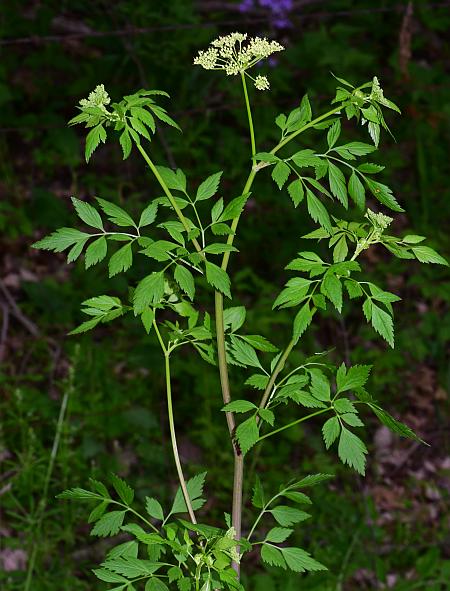Thaspium chapmanii (J.M. Coult. & Rose) Small
Chapman's Meadow-Parsnip

Native
CC = 7
CW = 3
MOC = 57
© SRTurner
Thaspium chapmanii (J.M. Coult. & Rose) SmallChapman's Meadow-Parsnip | |
 |
Native CC = 7 CW = 3 MOC = 57 |
© SRTurner |
|
Family - Apiaceae Habit - Fibrous-rooted perennial forb. Stems - Erect, to 1.1 m, usually pubescent with a band of short, white hairs at the base of at least the uppermost leaf sheaths, sometimes also sparsely and minutely hairy toward the tip.
Leaves - Basal leaves with the blades 6-25 cm long, 2 or 3 times compound, the leaflets 1-12 cm long, lanceolate to ovate, tapered to rounded at the base, sometimes with 1 or 2 lobes toward the base, the margins otherwise finely to coarsely toothed, short-hairy, not whitened, the upper surfaces glabrous to sparsely pubescent, the lower surfaces moderately pubescent with straight, white, speading hairs. Stem leaves similar to the basal leaves, gradually reduced in size and degree of dissection toward the stem tip.
Inflorescences - Terminal and axillary, compound umbels, short-to long-stalked. Involucre usually absent. Rays 9-16, 1-4 cm long, nearly equal in length, adaxially scabrellous. Involucel of linear bractlets, the bractlets shorter than the flower stalks. Flowers 9-19 or more in each umbellet, all with short stalks (1-5 mm long).
Florets - Florets 9-19 (to numerous) in each umbellet, all with short stalks (1-4 mm long). Sepals absent or more commonly minute, triangular to obovate scales. Petals obovate, narrowed or tapered abruptly to a short, slender tip, cream-colored to pale yellow. Ovaries glabrous.
Fruits - Schizocarps, 4-5 mm long at maturity, ovate, flattened dorsally, glabrous, the mericarps with 5 ribs, these with prominent, somewhat corky, light yellow to straw-colored wings, scabrellous between and sometimes on several wings, with prominent reddish brown oil tubes filling the spaces between the ribs.
Flowering - May - June. Habitat - Glades, bluff tops, prairies, rocky banks, stream floodplains, and open woodlands. Origin - Native to the U.S. Other info. - The presence of this species in Missouri, as an entity distinct from T. barbinode, has recently been published by Dr. Aaron Floden (Missouriensis 2019, 37). It appears that the majority of specimens determined in the past as T. barbinode are more consistent with T. chapmanii. The two species are very similar, but T. chapmanii has florets which are pale yellow (vs. bright yellow or golden in T. barbinode) and leaflet undersurfaces which are evenly pubescent (vs. pubescent only on primary veins in T. barbinode). Both species have umbellets in which all florets are stalked, and fruits with conspicuous wings on the ribs. As circumscribed above, T. chapmanii is reasonably common in the southern half of Missouri, uncommon to absent in the northern portion of the state. Outside of Missouri the species occupies a band from southern Michigan southward through Alabama. As the plant's recognition becomes more common, this known range will probably expand. Photographs taken near St. Albans, Franklin County, MO, 4-30-2012, at St. Joe State Park, St. Francois County, MO, 5-13-2015, at Ruth and Paul Henning Conservation Area, Taney County, MO, 7-28-2016, and along the Katy Trail near Treloar, Warren County, MO, 5-4-2020 and 7-4-2020 (SRTurner). |